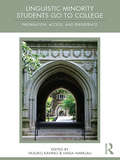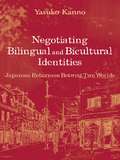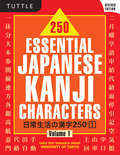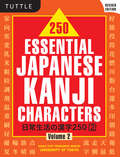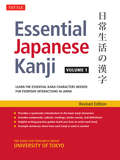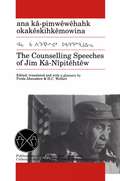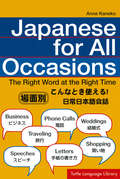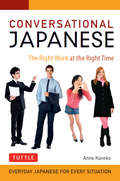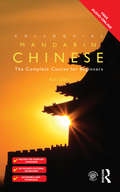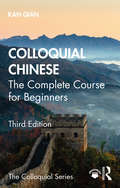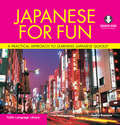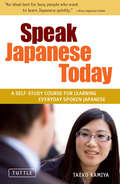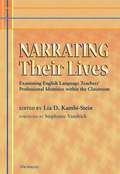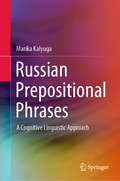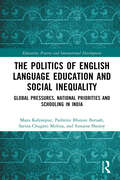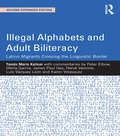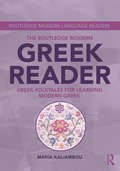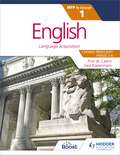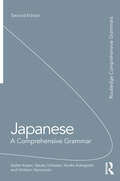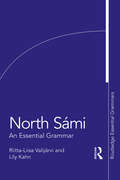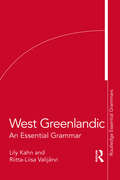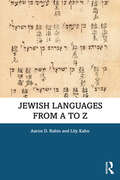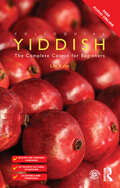- Table View
- List View
Linguistic Minority Students Go to College: Preparation, Access, and Persistence
by Yasuko Kanno Linda HarklauCurrently, linguistic minority students – students who speak a language other than English at home – represent 21% of the entire K-12 student population and 11% of the college student population. Bringing together emerging scholarship on the growing number of college-bound linguistic minority students in the K-12 pipeline, this ground-breaking volume showcases new research on these students’ preparation for, access to, and persistence in college. Other than studies of their linguistic challenges and writing and academic literacy skills in college, little is known about the broader issues of linguistic minority students’ access to and success in college. Examining a variety of factors and circumstances that influence the process and outcome, the scope of this book goes beyond students’ language proficiency and its impact on college education, to look at issues such as student race/ethnicity, gender, SES, and parental education and expectations. It also addresses structural factors in schooling including tracking, segregation of English learners from English-fluent peers, availability and support of institutional personnel, and collegiate student identity and campus climate. Presenting state-of-the-art knowledge and mapping out a future research agenda in an extremely important and yet understudied area of inquiry, this book advances knowledge in ways that will have a real impact on policy regarding linguistic minority immigrant students’ higher education opportunities.
Negotiating Bilingual and Bicultural Identities: Japanese Returnees Betwixt Two Worlds
by Yasuko KannoThis book examines the changing linguistic and cultural identities of bilingual students through the narratives of four Japanese returnees (kikokushijo) as they spent their adolescent years in North America and then returned to Japan to attend university. As adolescents, these students were polarized toward one language and culture over the other, but through a period of difficult readjustment in Japan they became increasingly more sophisticated in negotiating their identities and more appreciative of their hybrid selves. Kanno analyzes how educational institutions both in their host and home countries, societal recognition or devaluation of bilingualism, and the students' own maturation contributed to shaping and transforming their identities over time. Using narrative inquiry and communities of practice as a theoretical framework, she argues that it is possible for bilingual individuals to learn to strike a balance between two languages and cultures. Negotiating Bilingual and Bicultural Identities: Japanese Returnees Betwixt Two Worlds: *is a longitudinal study of bilingual and bicultural identities--unlike most studies of bilingual learners, this book follows the same bilingual youths from adolescence to young adulthood; *documents student perspectives--redressing the neglect of student voice in much educational research, and offering educators an understanding of what the experience of learning English and becoming bilingual and bicultural looks like from the students' point of view; and *contributes to the study of language, culture, and identity by demonstrating that for bilingual individuals, identity is not a simple choice of one language and culture but an ongoing balancing act of multiple languages and cultures. This book will interest researchers, educators, and graduate students who are concerned with the education and personal growth of bilingual learners, and will be useful as text for courses in ESL/bilingual education, TESOL, applied linguistics, and multicultural education.
250 Essential Japanese Kanji Characters Volume 1 Revised
by Kanji Text University of Tokyo"This is the best kanji book available today. Designed for beginners with a basic knowledge of Japanese to use in the classroom on for self-study."--Modern Language JournalEveryday tasks like finding a street address or buying a train ticket can be an ordeal in Japan if you don't read kanji-the system of Japanese writing based on Chinese characters. A group of teachers from the prestigious University of Tokyo have pooled their talents to create 250 Essential Japanese Kanji Characters in two volumes: a practical way to learn the kanji most frequently used in daily life in Japan. Each lesson helps you master a new group of kanji, using an extremely effective approach that focuses on you, the learner, taking an active part.Introductory Quizzes introduce everyday situations where you encounter kanji.Vocabulary sections help you understand the readings and meanings of the kanji.New Character Charts teach you new kanji systematically—for each character you'll learn its meanings, its basic on-kun readings, its stroke order, common compounds, and derivations.Practice sections help you improve your skills in recognizing and using the kanji.Advanced Placement Exam Practice Questions for each lesson follow the format of the College Boards Japanese Language and Culture examination.
250 Essential Japanese Kanji Characters Volume 1 Revised
by Kanji Text University of Tokyo"This is the best kanji book available today. Designed for beginners with a basic knowledge of Japanese to use in the classroom on for self-study."--Modern Language JournalEveryday tasks like finding a street address or buying a train ticket can be an ordeal in Japan if you don't read kanji-the system of Japanese writing based on Chinese characters. A group of teachers from the prestigious University of Tokyo have pooled their talents to create 250 Essential Japanese Kanji Characters in two volumes: a practical way to learn the kanji most frequently used in daily life in Japan. Each lesson helps you master a new group of kanji, using an extremely effective approach that focuses on you, the learner, taking an active part.Introductory Quizzes introduce everyday situations where you encounter kanji.Vocabulary sections help you understand the readings and meanings of the kanji.New Character Charts teach you new kanji systematically—for each character you'll learn its meanings, its basic on-kun readings, its stroke order, common compounds, and derivations.Practice sections help you improve your skills in recognizing and using the kanji.Advanced Placement Exam Practice Questions for each lesson follow the format of the College Boards Japanese Language and Culture examination.
250 Essential Japanese Kanji Characters Volume 2 Revised
by Kanji Text University of TokyoTackling kanji-the system of Japanese writing based on Chinese characters-is the most challenging aspect of learning the Japanese language. 250 Essential Japanese Kanji Characters Volume 1 and Volume 2 are time-tested books that have now been enhanced and revised using proven methods from the Kanji Text Research Group at the University of Tokyo.Together, these updated volumes incorporate all 410 kanji required for the AP exam, along with practice questions. Each lesson helps you master a new group of kanji, with either an etymology or a memory aid offered to give students a basis for understanding and memorizing the kanji systematically and correctly.
Essential Japanese Kanji Volume 1
by Kanji Text University of TokyoMemorize tricky Japanese kanji with ease!Since its publication in 1993, this beginner Japanese workbook and textbook has been a hit with teachers and students for learning basic Japanese kanji characters. Speak, read and write Japanese with this newly revised edition that has been updated and expanded by members of the Kanji Text Research Group at the prestigious Tokyo University.Essential Japanese Kanji Volume 1 presents the 250 kanji characters that are most frequently found in many places in Japan, including: Street signs Restaurant menus Subway ticket machines ATMsStroke order diagrams and writing practice squares present every kanji systematically alongside its various meanings, readings, vocabulary compounds and derivations. Extensive practice exercises and self-graded quizzes (with answer keys at the back) help you improve your skill at recognizing and using the kanji.In addition to the practical focus of learning the kanji in the context of actual situations, each chapter includes Advanced Placement (AP)-type exam questions mirroring the format of the College Board's Japanese Language and Culture examination. The captivating introduction explains the origins of the kanji and the Japanese kana phonetic alphabets. Appendices list the kanji in two ways-according to pronunciations and radicals-and a glossary of common vocabulary compounds.
The Counselling Speeches of Jim Ka-Nipitehtew (Algonquian Text Society)
by Jim Kâ-NîpitêhtêwJim Ka-Nipitehtew was a respected Cree Elder from Onion Lake, Saskatchewan, who spoke only Cree and provided these original counselling discourses. The book offers the speeches in Cree syllabics and in Roman Orthography as well as an English translation and commentary. The Elder offers guidance for First Nations people in these eight speeches that cover the proper performance of ceremonies, words of encouragement for youth, information about collecting medicinal plants, directions for proper behaviour of men toward women, proper preparations for the Pipe ceremony, the role of the Pipestem in the Making of Treaty 6, the importance of tobacco, and examples of improper ritual behaviour in ceremonies. One of the most important speeches is the narrative of the Cree record for the treaty negotiations that took place in the summer of 1876. It was originally transmitted by Jim Ka-Nipitehtew's father directly to him and the authors comment on this remarkable chain of transmission. The book contains a Cree-English and an English-Cree Glossary. This is an important resource for Cree linguistics as well as those interested in understanding the Cree perspective of Treaty 6.
Japanese for All Occasions
by Anne Kaneko Sally MotomuraAt last. A book of useful Japanese, offering the language you need to handle a wide variety of situations. Through hundreds of example sentences and dialogues, you'll learn what to say and do when:Setting up a business appointmentOpening a bank accountMaking a wedding speechReserving a place to stayRenewing a visaand much moreIncluded is an additional chapter on writing cards and letters, featuring examples of New Year cards, thank-you notes, and normal letters.No other book covers colloquial Japanese as thoroughly as Japanese for All Occasions. Whether you're a student, traveler, or businessperson, you'll find that this book offers any easy and enjoyable way to improve your Japanese.
Conversational Japanese
by Anne KanekoThis book is a user-friendly language guide for basic spoken Japanese.More than a phrase book, Conversational Japanese provides basic material for practical day-to-day communication. Through hundreds of example sentences and dialogs, as well as thorough explanations of the customs involved, learners will know what to say and do when:Meeting new peopleReserving a hotel roomBuying a train ticketOffering a giftWriting email, business letters, cards and thank-you notesThis book is about communication. As we all know communication is more than just language. Our body language is just as important, as we all bring a host of personal and cultural baggage to each conversation we have. To communicate successfully in another culture and speak Japanese we need more than the bare bones of the language.Unlike most language books, Conversational Japanese does not restrict the use of kanji (Chinese characters), and the sentences are written in the usual Japanese combination of kana (hiragana and katakana) and kanji. Since learning kanji is a difficult task, Conversational Japanese includes romanji (Romanized Japanese) for each word or phrase. As you progress, using kanji and kana will become easier to remember and you should be able to pick up new kanji over time.
Colloquial Chinese: The Complete Course for Beginners
by Qian KanColloquial Chinese: The Complete Course for Beginners has been carefully developed by an experienced teacher to provide a step-by-step course to Chinese as it is written and spoken today. Combining a clear, practical and accessible style with a methodical and thorough treatment of the language, it equips learners with the essential skills needed to communicate confidently and effectively in Chinese in a broad range of situations. No prior knowledge of the language is required. Colloquial Chinese is exceptional; each unit presents a wealth of grammatical points that are reinforced with a wide range of exercises for regular practice. A full answer key, a grammar summary, bilingual glossaries and English translations of dialogues can be found at the back as well as useful vocabulary lists throughout. Key features include: A clear, user-friendly format designed to help learners progressively build up their speaking, listening, reading and writing skills Jargon-free, succinct and clearly structured explanations of grammar An extensive range of focused and dynamic supportive exercises Realistic and entertaining dialogues covering a broad variety of narrative situations Helpful cultural points explaining the customs and features of life in China An overview of the sounds of Chinese Balanced, comprehensive and rewarding, Colloquial Chinese is an indispensable resource both for independent learners and students taking courses in Chinese. Audio material to accompany the course is available to download free in MP3 format from www.routledge.com/cw/colloquials. Recorded by native speakers, the audio material features the dialogues and texts from the book and will help develop your listening and pronunciation skills.
Colloquial Chinese: The Complete Course for Beginners
by Qian KanColloquial Chinese: The Complete Course for Beginners has been carefully developed by a leading academic in Chinese language teaching and course design. Based on feedback from learners and teachers who used its previous version, this new edition has been updated to reflect the language and cultural changes in China, such as online shopping and WeChat payment, and to provide a more integrated and step-by-step approach to making the learning of modern Mandarin Chinese more effective and enjoyable. Combining a clear, practical and accessible style with a methodical and thorough treatment of the language, it equips learners with the essential knowledge and skills needed to communicate confidently and effectively in Chinese in a broad range of situations. No prior knowledge of the language is required. Colloquial Chinese is exceptional; each unit presents a wealth of grammatical points that are reinforced with a wide range of exercises for regular practice. A full answer key, a grammar summary, bilingual glossaries and English translations of dialogues can be found at the back, as well as transcripts of listening practice exercises. Key features include: A clear, user-friendly format designed to help learners progressively build up their speaking, listening, reading and writing skills Jargon-free, succinct and clearly structured explanations of grammar Step by step introduction of Chinese characters An extensive range of focused and dynamic supportive exercises A combination of listening, reading and speaking activities with the support of transcripts at the back of the book Realistic and entertaining dialogues covering a broad variety of narrative situations Helpful cultural points explaining the customs and features of life in China An overview of the Chinese language: its sounds, structure and Chinese characters Balanced, comprehensive and rewarding, Colloquial Chinese is an indispensable resource both for independent learners and students taking courses in Chinese as well as teachers of Chinese. Audio material to accompany the course is available to download free in MP3 format from www.routledge.com/cw/colloquials. Recorded by native speakers, the audio material features the dialogues, new words and listening practice exercises from the book and will help develop your listening and speaking skills.
Japanese for Fun: A Practical Approach to Learning Japanese Quickly
by Taeko KamiyaThis is a concise guide to learning basic Japanese.This pocket book is intended for people who want to learn Japanese quickly. <P><P> Whenever you have a few minutes- waiting in a hotel lobby, riding on a train, or whatever-open this book and you can learn phrases you'll use again and again during your stay in Japan. The book is divided into twenty-one chapters, each covering a specific topic. Each chapter includes the following three sections:Words & Expressions: This section introduces words and expressions needed in specific situations. Vocabulary is presented systematically for quick and easy understanding.Expressions in Context: This shows how to use in context the words and expressions given in the preceding section. Gives you confidence in using new words in original sentences.Additional Words & Expressions: This section enables you to create many new sentences using the patterns just learned. There's no need to memorize all the words or phrases presented here: concentrate on just those you want to use.To use this book, start by reading the first three chapters of the book. These introduce many of the most commonly used words and phrases, and familiarize you with the basic sentence structures. After Chapter
Speak Japanese Today: A Self-Study Course for Learning Everyday Spoken Japanese
by Taeko KamiyaThis self-study book is an perfect choice for learning Japanese quickly. Speak Japanese Today is ideal for students, business people and travelers. It offers the option to learn Japanese in a short time without compromising on quality.<P><P>Beginning Japanese learners are often intimidated by the oddly shaped Japanese Characters (kanji and kana) and exotic-sounding pronunciations, but Speak Japanese Today breaks down the Japanese language and presents it to you in twenty short and concise lessons and two review chapters that are specially designed to be absorbed quickly and stay in your long-term memory. Only the most commonly spoken Japanese translations of key phrases are included, allowing you to maximize your time.Included in this book are:Everyday key vocabularyReal-life dialogs-taken from actual Japanese speakers!Important and useful grammar pointsExtensive review exercisesAn expanded appendix including pronunciation charts and grammar rulesJapanese to English and English to Japanese indexes for quick word look-up and reference
Narrating Their Lives: Examining English Language Teachers' Professional Identities Within The Classroom
by Lia Kamhi-Stein Stephanie Vandrick“…a groundbreaking book that will…engage, inform, and connect with present and future teachers and teacher educators. ” ---Stephanie Vandrick, Foreword to Narrating Their Lives The field of TESOL has called attention to the ways that the issues of race and ethnicity, language status and power, and cultural background affect second language learners’ identities and, to some degree, those of teachers. In Narrating Their Lives, Kamhi-Stein examines the process of identity construction of classroom teachers so as to make connections between their personal and professional identities and their instructional practices. To do that, she has selected six autobiographical narratives from teachers who were once part of her TESL 570 (Educational Sociolinguistics) class in the MA TESOL program at California State University, Los Angeles. These six narratives cover a surprisingly wide range of identity issues but also touch on broader instructional themes that are part of teacher education programs. Because of the reflective nature of the narratives—with the teachers using their stories to better understand how their experiences shape what they do in the classroom—this volume includes provocative chapter-opening and reflective chapter-closing questions. An informative discussion of the autobiographical narrative assignment and the TESL 570 course (including supplemental course readings and assessment criteria) is also included.
Russian Prepositional Phrases: A Cognitive Linguistic Approach
by Marika KalyugaThe book presents a comprehensive study of Russian prepositions, with a focus on expressing spatial characteristics. It primarily deals with how metaphorical and metonymical transfers motivate the use of Russian prepositional phrases, explaining the collocations of prepositional phrases with verbs as a realisation of a conceptual metaphor or a metonymy. The author confronts a problem that is attracting growing attention within present-day linguistics: the semantics of prepositions and cases. The book seeks to clarify the conceptual motivations for the use of the combinations of Russian primary prepositional phrases, as well as to demonstrate how their spatial meanings are extended into non-spatial domains. This book incorporates an analysis of a large number of items, including 30 combinations of primary prepositions with cases. An original contribution, the book is of interest to teachers and students studying Slavic languages, and to cognitive linguists.
The Politics of English Language Education and Social Inequality: Global Pressures, National Priorities and Schooling in India (Education, Poverty and International Development)
by Maya Kalyanpur Padmini Bhuyan Boruah Sarina Chugani Molina Sunaina ShenoyBased on policy analysis and empirical data, this book examines the problematic consequences of colonial legacies of language policies and English language education in the multilingual contexts of the Global South. Using a postcolonial lens, the volume explores the raciolinguistics of language hierarchies that results in students from low-income backgrounds losing their mother tongues without acquiring academic fluency in English. Using findings from five major research projects, the book analyzes the specific context of India, where ambiguous language policies have led to uneasy tensions between the colonial language of English, national and state languages, and students’ linguistic diversity is mistaken for cognitive deficits when English is the medium of instruction in schools. The authors situate their own professional and personal experiences in their efforts at dismantling postcolonial structures through reflective practice as teacher educators, and present solutions of decolonial resistance to linguistic hierarchies that include critical pedagogical alternatives to bilingual education and opportunities for increased teacher agency. Ultimately, this timely volume will appeal to researchers, scholars, academics, and students in the fields of international and comparative education, English and literacy studies, and language arts more broadly. Those interested in English language learning in low-income countries specifically will also find this book to be of benefit to their research.
Illegal Alphabets and Adult Biliteracy: Latino Migrants Crossing the Linguistic Border, Expanded Edition
by Tomás Mario KalmarHow do "illegal aliens" chart the speech sounds of colloquial English? This book is timeless in offering an unusually direct entry into how a group of Mexican fruit pickers analyze their first encounter with local American speech in a tiny rural Midwestern community in the United States. Readers see close up how intelligently migrant workers help each other use what they already know—the alphabetic principle of one letter, one sound—to teach each other, from scratch, at the very first contact, a language which none of them can speak. They see how and why the strategies adult immigrants actually use in order to cope with English in the real world seem to have little in common with those used in publicly funded bilingual and ESL classrooms. What’s new in this expanded edition of Tomás Mario Kalmar’s landmark Illegal Alphabets and Adult Biliteracy are in-depth commentaries from six distinguished scholars—Peter Elbow, Ofelia García, James Paul Gee, Hervé Varenne, Luis Vázquez León, Karen Velasquez—who bring to it their own personal, professional, and (multi)disciplinary viewpoints.
The Routledge Modern Greek Reader: Greek Folktales for Learning Modern Greek
by Maria KaliambouThe Routledge Modern Greek Reader has been specially designed for post-beginners to advanced learners of Greek. Written by an experienced instructor, this innovative reader offers both students and teachers of Modern Greek the pedagogical tools to utilise richly textured folktale material in a language class. Students can develop their linguistic skills while simultaneously engaging with the broader social and cultural context of the language. Features include: Twenty five readings organised according to level of difficulty, beginning with easy short stories and progressing onto more advanced level texts Vocabulary lists with English translations and vocabulary in context supporting each reading Comprehension questions in each chapter to help foster stronger reading and writing skills Language exercises and subject specific tasks to stimulate classroom discussion and help students develop strong essay writing skills in Greek Three folktales presented in different dialects at the end of the book to help students understand variety within the Greek language itself A complete Greek-English glossary and a list of all idiomatic expressions and colloquial phrases found in the folktales. Suitable for both class use and independent study, The Routledge Modern Greek Reader is an essential tool for increasing language proficiency skills and enriching students’ cultural knowledge.
English for the IB MYP 1
by Zara Kaiserimam Ana de Castro Stephanie BarrusExam Board: MYPLevel: IBSubject: EnglishFirst Teaching: September 2016First Exam: June 2017Develop your skills to become an inquiring learner; ensure you navigate the MYP framework with confidence using a concept-driven and assessment-focused approach to English presented in global contexts.- Develop conceptual understanding with key MYP concepts and related concepts at the heart of each chapter.- Learn by asking questions with a statement of inquiry in each chapter. - Prepare for every aspect of assessment using support and tasks designed by experienced educators.- Understand how to extend your learning through research projects and interdisciplinary opportunities.
English for the IB MYP 1
by Zara Kaiserimam Ana de CastroExam Board: MYPLevel: IBSubject: EnglishFirst Teaching: September 2016First Exam: June 2017Develop your skills to become an inquiring learner; ensure you navigate the MYP framework with confidence using a concept-driven and assessment-focused approach to English presented in global contexts.- Develop conceptual understanding with key MYP concepts and related concepts at the heart of each chapter.- Learn by asking questions with a statement of inquiry in each chapter. - Prepare for every aspect of assessment using support and tasks designed by experienced educators.- Understand how to extend your learning through research projects and interdisciplinary opportunities.
Japanese: A Comprehensive Grammar (Routledge Comprehensive Grammars Ser.)
by Stefan Kaiser Yasuko Ichikawa Noriko Kobayashi Hilofumi YamamotoJapanese: A Comprehensive Grammar is a thorough reference guide to modern Japanese grammar. With its detailed treatment of all grammatical structures, it explores the complexities of the language fully, concentrating on the real patterns of use in contemporary Japanese as spoken and written by native speakers. This edition has been fully updated throughout, incorporating a new structure now organised by topic and providing specific attention to areas of particular difficulty. Examples have been updated throughout to reflect current usage and a glossary of linguistic terms has been added. Features include: Clear grammar points put into context using examples from a range of Japanese media Inclusive coverage of both colloquial and standard Japanese Extensive cross-referencing in all parts of the book A detailed index of Japanese and English terms Written by experts in this field, Japanese: A Comprehensive Grammar will be an essential reference source for the learner and user of Japanese at all levels.
North Sámi: An Essential Grammar (Routledge Essential Grammars)
by Lily Kahn Riitta-Liisa ValijärviNorth Sámi: An Essential Grammar is the most up-to-date work on North Sámi grammar to be published in English. The book provides: a clear and comprehensive overview of modern Sámi grammar including examples drawn from authentic texts of various genres. a systematic order of topics beginning with the alphabet and phonology, continuing with nominal and verbal morphology and syntax, and concluding with more advanced topics such as discourse particles, complex sentences, and word formation. full explanations of the grammatical terminology for the benefit of readers without a background in linguistics. ? Suitable for linguists, as well as independent and classroom-based students, North Sámi: An Essential Grammar is an accessible but thorough introduction to the essential morphology and syntax of modern North Sámi, the largest of the Sámi languages.
West Greenlandic: An Essential Grammar (Routledge Essential Grammars)
by Lily Kahn Riitta-Liisa ValijärviThis grammar provides a clear and comprehensive overview of contemporary West Greenlandic. It follows a systematic order of topics beginning with the alphabet and phonology, continuing with nominal and verbal morphology and syntax, and concluding with more advanced topics such as complex sentences and word formation. Grammatical points are illustrated with authentic examples reflecting current life in Greenland. Grammatical terminology is explained fully for the benefit of readers without a background in linguistics. Features include: Full grammatical breakdowns of all examples for ease of identifying individual components of complex words. A detailed contents list and index for easy access to information. An alphabetical list of the most commonly used West Greenlandic suffixes. A glossary of grammatical abbreviations used in the volume. The book is suitable for a wide range of users, including independent and classroom-based learners of West Greenlandic, as well as linguists and anyone with an interest in Greenland’s official language.
Jewish Languages from A to Z
by Lily Kahn Aaron D. RubinJewish Languages from A to Z provides an engaging and enjoyable overview of the rich variety of languages spoken and written by Jews over the past three thousand years. The book covers more than 50 different languages and language varieties. These include not only well-known Jewish languages like Hebrew, Yiddish, and Ladino, but also more exotic languages like Chinese, Esperanto, Malayalam, and Zulu, all of which have a fascinating Jewish story to be told. Each chapter presents the special features of the language variety in question, a discussion of the history of the associated Jewish community, and some examples of literature and other texts produced in it. The book thus takes readers on a stimulating voyage around the Jewish world, from ancient Babylonia to 21st-century New York, via such diverse locations as Tajikistan, South Africa, and the Caribbean. The chapters are accompanied by numerous full-colour photographs of the literary treasures produced by Jewish language-speaking communities, from ancient stone inscriptions to medieval illuminated manuscripts to contemporary novels and newspapers. This comprehensive survey of Jewish languages is designed to be accessible to all readers with an interest in languages or history, regardless of their background—no prior knowledge of linguistics or Jewish history is assumed.
Colloquial Yiddish
by Lily KahnSpecially written by an experienced teacher, Colloquial Yiddish offers a step-by-step approach to Yiddish as it is spoken and written today. Colloquial Yiddish provides the first widely available, easily accessible, comprehensive Yiddish course designed primarily for the twenty-first-century international English-speaking independent learner and suitable for use in Yiddish classes worldwide. Each unit presents numerous grammatical points that are reinforced with a wide range of exercises for regular practice. A full answer key can be found at the back as well as useful vocabulary summaries throughout. Key features include: graded development of speaking, listening, reading and writing skills realistic and entertaining dialogues jargon-free and clearly structured grammatical explanations a range of dynamic and appropriate supporting exercises supplementary texts presenting many of the most significant and relevant aspects of Yiddish culture. By the end of this rewarding course you will be able to communicate confidently and effectively in Yiddish in a broad range of situations. Course components: The complete course comprises the book and audio materials. These are available to purchase separately in paperback, ebook, CD and MP3 format. The paperback and CDs can also be purchased together in the great-value Colloquials pack. Paperback: 978-0-415-58019-9 (please note this does not include the audio) CDs: 978-0-415-58020-5 eBook: 978-0-203-85120-3 (please note this does not include the audio, available to purchase from http://ebookstore.tandf.co.uk/audio_viewbooks.aspx) MP3s: 978-0-415-58021-2 (available to purchase from http://ebookstore.tandf.co.uk/audio_viewbooks.aspx) Pack: 978-0-415-58022-9 (paperback and CDs)
